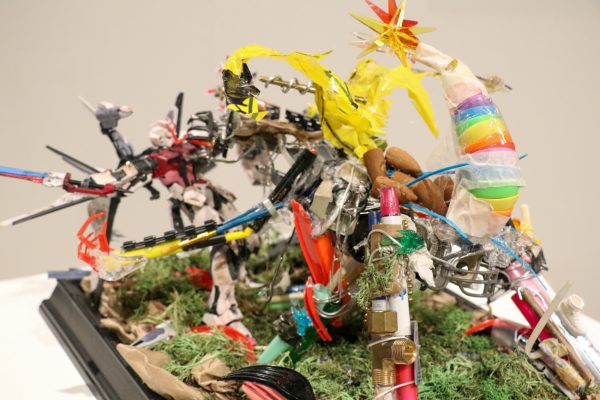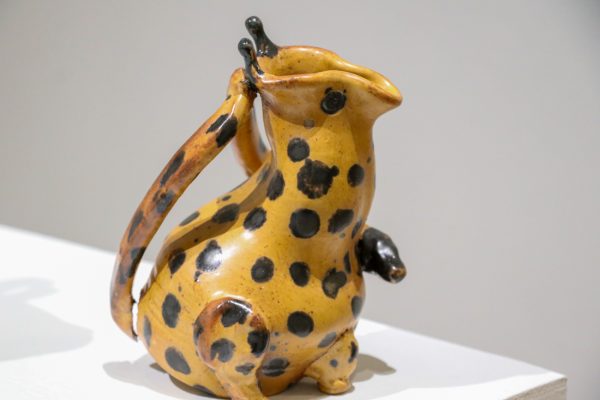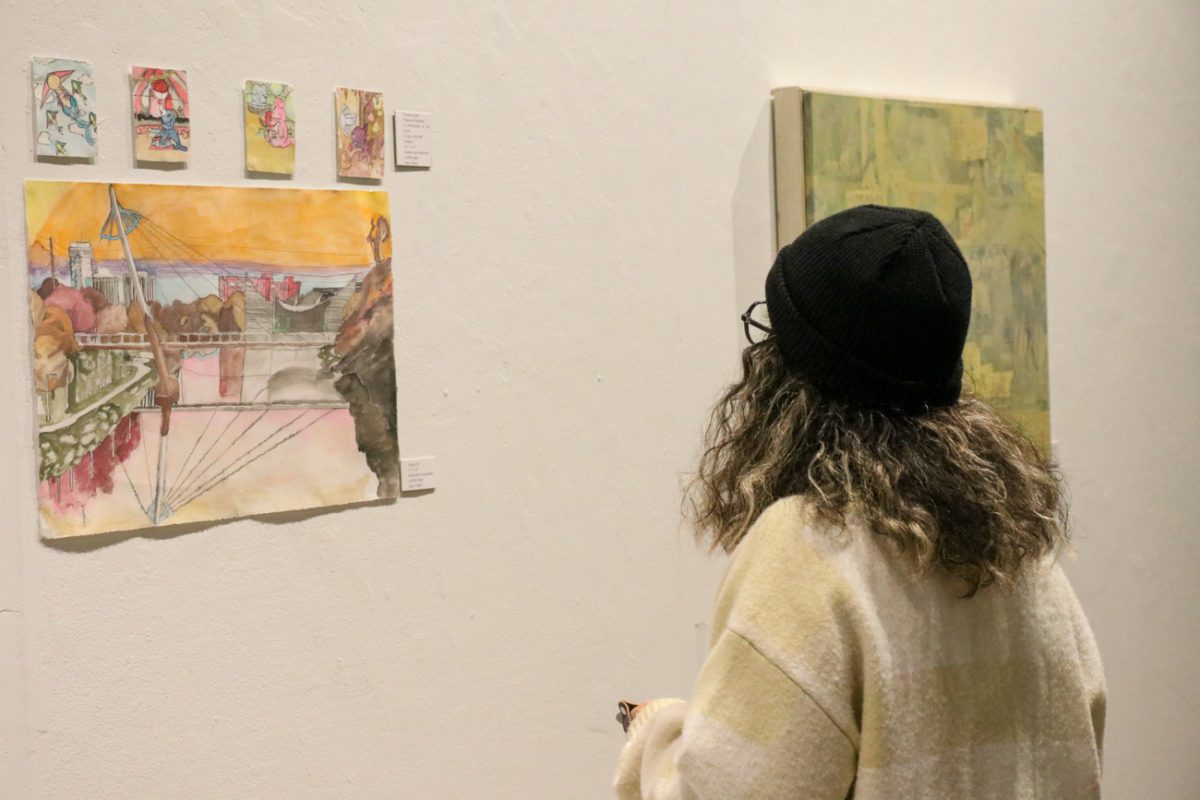“AT CRITS END: Taking Frames, Kicking Class” is a lot to behold. At first glance, it’s a conglomerate of multiple different kinds of art pieces. It seems chaotic and like puzzle pieces that don’t fit together quite right. At its core, it’s a physical representation of the artist’s class frustration with long hours and even longer critiques.
The gallery, curated by a Studio Tools and Presentation class at Wichita State, holds multiple minor themes such as personal strife, humanity, consumption, interaction, perspective, connection and even cats.
“The show as a whole, it has an almost incohesive cohesiveness,” senior Zelda McAfee said.
A description of the gallery said the “complexities of hosting a group show that encompasses so many different topics challenges us to find connections within each other. We are not taking criticism at this time. Thanks. :D.” This silly but true moment emphasizes the complexities of the art and the artist’s annoyance with judgment.
At the exhibition, there were three floors: the first was the title card and then the other two floors were curated by some of the students who had placed art into the show.
The third floor was co-curated by McAfee and fifth-year senior Isabella King. McAfee said that allowing students to curate is crucial in the art field but not without some challenges. It’s not displayed in your typical gallery — it’s a school building. There are fire alarms and wires and too many doors to count that can get in the way, and the students themselves were the ones curating the floors.
“With living artists, a lot of people want their art in very specific places and a lot of people want their art in those same specific places, so it’s a battle to figure out who goes where,” McAfee said. “I think that this was a really challenging space, but I think we were really successful in working with those challenges and finding those parts that made sense for the space.”
And they did pull it off — the pieces are placed in a way that draws your eyes from one to the next in a pleasing way. Not a single piece overshadows another, and they work together in a way that encapsulates the non-linear storytelling of their themes.
Within the multiple different outlets of this overarching theme, there were even more mediums. There’s everything from watercolors to building a figure out of discarded fidget toys.
Junior Bri’Quin Hadley had an interesting medium and an even more interesting inspiration.
“I always loved art, but I would say my first interest in art was probably Transformers,” Hadley said. “Definitely (film director) Michael Bay influenced me a lot. And my dad would buy me a lot of Transformers, and then I would just start to draw them. And then just from there, I started to branch out into different types of art.”

Hadley used items found in most American households such as plastic forks and old Expo markers. My favorite piece of his is titled “Steven strikes again.” It features what looks to be a scorpion-esque creature fighting a modified Transformers doll. The scorpion, Steven, is a literal amalgamation of trash and various items — his tail is a fidget rainbow worm, one of his claws is part of a paintbrush and his back leg is made of a marker tied to a miniature T-pipe, like what you would find under a sink.
This piece is a pure and unfiltered projection of what the imagination can do when released to full capacity.
Other artists, like junior Noah Hutchinson, weren’t inspired by a certain franchise, but rather certain genres and subjects of art.
“All of my work really consists of either microscopic or zoomed-in, high-detail anatomy studies,” Hutchinson said. “And then kind of twisting it … (with) a comic book graphic type of style.”
The piece that stood out the most to me by Hutchinson was entitled “Wash Your Hands.” It was a comically large, cartoonish face drawn in the fashion of those tiny, green germs you see in cartoons. The face is screaming at you, and the red background surrounding the green germ gives the impression that it’s coming toward you.
This is a cool piece. The art is well done, the line work is impeccable and the style is so unique to some of the other styles in the gallery that it’s hard not to notice when you walk by.
Then again, other artists didn’t focus on the medium as much, but instead on the message they were trying to convey.
“From my art, I would like (spectators) to understand how I’m viewing the world for women’s bodies,” McAfee said. “ I did a work based on Greek gods. I used modern bodies so they’re not perfect marble sculptures, but they’re supposed to look like sculptures because of how society treats us.”
McAfee has completed and displayed two pieces from this series. They’ve done Artemis, the Greek goddess of the moon, and Aphrodite, the Greek goddess of love and beauty.
McAfee used photography to depict this vision. For Artemis, they had someone else pose for the portrait, and for Aphrodite, McAfee posed for their own piece.
These pieces are beautiful — McAfee perfectly captured the sculpture vibe for the portraits. The outfits were an amazing representation of the time frame being emulated.
It was also a genius idea to use Greek goddesses for this specific premise — beings described as nearly perfect and powerful, yet still turned into objects that show how our society views them.
Not only was “AT CRITS END” a way for artists to release frustrations, but it was also a way for them to show outside spectators the visualization of their annoyance — without critiques.

“For student art to be available to the public for free, just to come and view is really important,” junior Lily Arens said. “It’s a great way for the public to be able to talk with artists as well, because especially in galleries or museums, often the artist isn’t actually there. So being able to actually speak with the people that made the art can really give people perspective on the meaning.”
Students like King find public attention helpful, not just because of the direct communication between artist and spectator, but also because it helps smash certain stigmas around art students.
“Since (the public) is able to come out and see these for free, I think it helps people kind of understand different types of art and kind of gets rid of that stigma against rich students,” King said. “I feel like a lot of older people especially are like, ‘Oh you go to art school, what do you make money with?’ And it’s not always about that, it’s sometimes just about the art and it’s good for them to be able to see that.”
Despite all the stigmas and the challenges, artists will continue to be inspired, either by pressing societal problems, like McAfee, or the hit series “Transformers,” like Hadley, and will continue to make art.
“We’re aspiring artists and we’re just going to keep going,” Hadley said. “They should just continue coming out and supporting the origin of art and the students. Art is life.”




